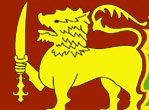| |
 |
 |












|
|
|
 |
 |
Sri Lanka
The Aryans arrived in Sri Lanka late in
the 6th century B.C. from northern India. Buddhism was introduced
beginning in about the mid-third century B.C., and a great
civilization developed at the cities of
Anuradhapura (kingdom from circa 200 B.C. to circa A.D.
1000) and
Polonnaruwa (from about 1070 to
1200). In the 14th century, a South Indian dynasty seized power in
the north and established a Tamil kingdom. Occupied by the
Portuguese in the 16th century and by the Dutch in the 17th century,
the island was ceded to the British in 1796, became a crown colony
in 1802, and was united under British rule by 1815. As Ceylon, it
became independent in 1948; its name was changed to Sri Lanka in
1972.
Geographically, Sri Lanka is an island
situated in the Indian Ocean, at the base of the Indian
Sub-Continent, 880 km north of the equator. Sri Lanka has a pleasant
tropical climate. The average temperature of the low lands ranges
between 25-30 degrees Celsius. It is a multi-ethnic, multi-religious
country with a diverse and rich culture with a total population of
19 million.
|
|
Literacy
Percent
Male:
92.3%
Female: 89.1% (2001 census)
|
|
|
|
|
Capital
Colombo
(Administrative)
Sri Jayawardenapura
Kotte (Legislative) |
Language
Sinhala,
Tamil, English |
|
|
|
|
Area
Total: 65,610 sq km
Land: 64,740 sq km
Water: 870 sq km |
Climate
Pleasant
tropical climate.
Tropical monsoon,
northeast monsoon (December to March); southwest
monsoon (June to October)
|
|
|
|
|
GDP per Capita
U.S. $4,700 |
Currency
Sri Lankan
Rupees (Rs) |
|
|
|
|
Ethnic Groups
Sinhalese
73.8%, Sri Lankan Moors 7.2%, Indian Tamil 4.6%, Sri
Lankan Tamil 3.9%, other 0.5%, unspecified 10% (2001
census provisional data) |
Religion
Buddhist
69.1%, Muslim 7.6%, Hindu 7.1%, Christian 6.2%,
unspecified 10% (2001 census provisional data) |
|
|
|
|
Agriculture - products
Rice, sugarcane,
grains, pulses, oilseed, spices, tea, rubber,
coconuts; milk, eggs, hides, beef; fish
|
Legal System
Mixture
of English Common Law, Roman-Dutch, Islamic,
Sinhalese, and Customary Law
|
|
|
|
|
Find more facts about Sri
Lanka |
|
|
|
|
Anuradhapura:
Anuradhapura,is one of the
ancient capitals of Sri Lanka, world famous for its well
preserved ruins of the Great Sri Lankan Civilization. The
city now a UNESCO heritage site, lies 205 km north of the
current capital Colombo in the North Central Province of Sri
Lanka.
Polonnaruwa:
The second most ancient of Sri Lanka's kingdoms, Polonnaruwa was
first declared the capital city by King Vijayabahu I, who
defeated the Chola invaders in 1070 CE to reunite the country
once more under a local leader.
Kandy:
Kandy is the
English name for the city of Maha Nuvara (Senkadagalapura) in
the centre of Sri Lanka. It is the capital of the Central
Province and Mahanuvara District. It lies in the midst of hills
in the Kandy Valley which crosses an area of tropical
plantations, mainly tea.
Nuwara
Eliya:
The town was founded by
Samuel Baker as a hill retreat for the British during the
colonial era, where typical English pastimes including fox
hunting, polo and cricket were played.
Many of the buildings retain features from the colonial period,
and even new hotels are often built and furnished in the
colonial style.
Galle:
Galle is a town situated on
the southwestern tip of Sri Lanka, 119 km from Colombo. Galle
was known as Gimhathiththa (although Ibn Batuta in the 14th
century refers to it as Qali) before the arrival of the
Portuguese in the 16th century, when it was the main port on the
island.
|
|
|
|
|
Home | About
Sri Lanka | FAQs | Travel
Tips | Contact
Us |
Designed by eDesigners |
|
|
|
|
 |
|
| |
 |
| |
|
| |
 |
| |
Sea, Sun and Sand :
|
| |
No matter what time of the year, you can find a beach that is in
season and just waiting to welcome you to this warm sands.
|
| |
|
| |
 |
| |
Ancient Cities and Culture
:
|
| |
Island that is an eclectic mix of its colonial history, religious
traditions and South Asian influence. Sri Lanka’s unique culture,
which is authentic to this island, brings together its pluralistic
identity. |
| |
|
| |
 |
| |
Wildlife Safari :
|
| |
Sri Lanka has strived to provide sanctuary and protection to it's
beautiful wildlife. There are many wild life reserves, nature parks
and sanctuaries established throughout and extremely popular with
local and overseas visitors. |
| |
|
| |
 |
| |
Nature Trails , Fauna & Flora :
|
| |
Scenic routes, a hint of adventure and the most diverse flora and
fauna you’ve ever seen. The island is your very own tropical voyage
waiting to happen. |
| |
|
|
|
 |
| |
Adventure Tours
:
|
| |
There is simply nothing a tourist could not do in Sri Lanka. We
offer the guided activities like Tracking, bird watching, jungle
safaris, diving, white water rafting etc. |
| |
|
|
|